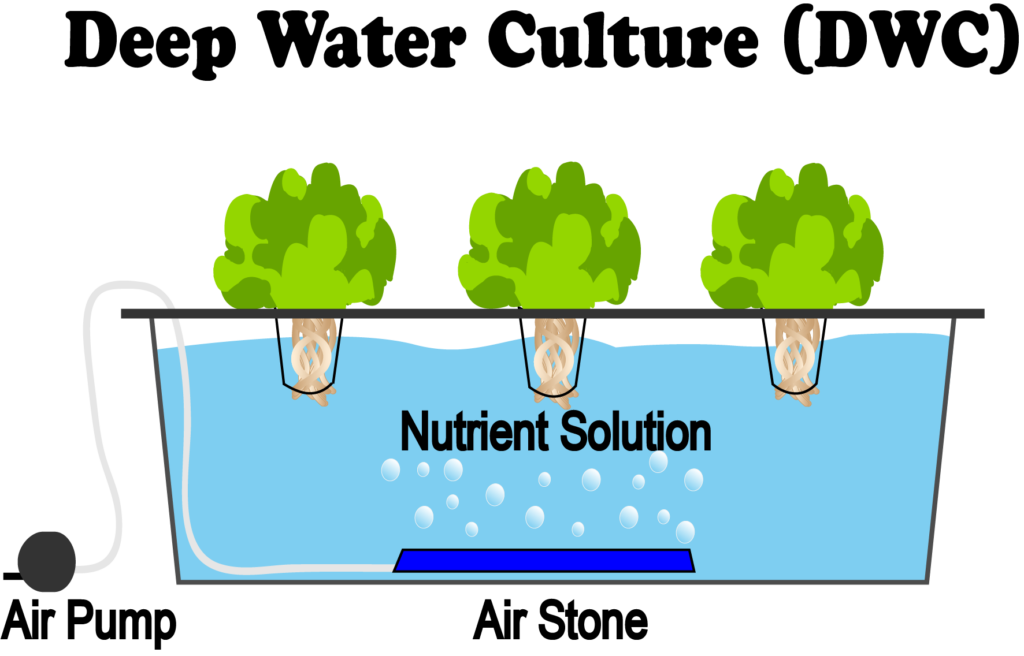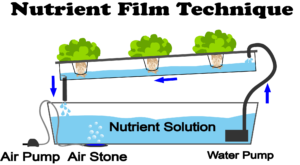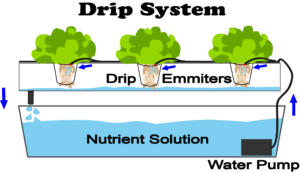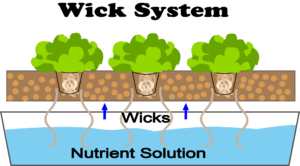Hydroponics is exploding in popularity—and for good reason. You can grow fresh veggies year-round without soil, even if you live in an apartment.
But if you’re just getting started, choosing a system can feel confusing. What’s better—DWC or NFT? Which one is easiest? Which system costs the least to build?
In this guide, I’ll break down the 6 main types of hydroponic systems, how they work, their pros and cons, and which one might be best for you. Let’s dig in—well, not literally, because we’re skipping the soil.
Deep Water Culture (DWC) Hydroponic Systems
What It Is:
In a Deep Water Culture system, plant roots are suspended directly in a nutrient-rich water solution. An air stone and pump keep the water oxygenated so roots don’t suffocate. Because the plants are sitting in nutrients and being supplied with unlimited oxygen, they grow like crazy. You’ll be amazed at how big the root system gets and how quickly it happens!
How It Works:
Plants are placed in net pot bucket lids
Roots dangle into a reservoir of nutrient solution
An air pump adds oxygen to solution to keep roots healthy

Learn more about DWC hydroponic systems
Pros:
✅ Simple and inexpensive
✅ Low maintenance once set up
✅ Great for beginners
✅ Good for large plants
Cons:
❌ Water temp and pH can fluctuate
❌ Power outages = risk of oxygen loss
❌ Some systems can be heard to regulate nutrient temp.
Best For: Lettuce, basil, kale, spinach, and fast-growing leafy greens.If supported well, tomatoes and peppers.
Pro Tip:
Keep your water between 65–70°F (18–21°C) for optimal oxygen absorption. Add frozen water bottles in summer if needed.
Build It: The hydroponic bucket also called a bubble bucket, is an excellent example of a DWC hydroponic system. You can also check out this article on How To Make A 5 Gallon Bubble Bucket. Plastic totes are also used frequently instead of buckets.
My Top Pick | 1,400+ Reviews |
Nutrient Film Technique (NFT) Hydroponic Systems
What It Is:
NFT systems use a thin stream—or “film”—of nutrient-rich water that flows constantly over plant roots inside a shallow channel or tube.
How It Works:
Water flows from a reservoir through slightly tilted channels
Plant roots absorb nutrients from the moving water
Water collects back into the reservoir to recirculate

Learn more about NFT hydroponic systems
Pros:
✅ Very water-efficient
✅ Great for herbs and leafy greens
✅ Easy to expand with more channels
Cons:
❌ Pump failure = quick root death
❌ Not ideal for heavy or large-rooted plants
❌ Channels must be kept clean to prevent blockages
Best For: Lettuce, basil, arugula, mint, and other fast-growing greens.
Pro Tip:
Keep the flow rate low so the nutrient film just coats the bottom of the channel—too much water can drown the roots.
My Top Pick | 170+ Reviews |
Ebb And Flow/Flood & Drain Hydroponic Systems
What It Is:
An Ebb and Flow system (also called Flood & Drain) temporarily floods the plant roots with nutrient solution, then drains it back into a reservoir.
How It Works:
Plants sit in a grow bed filled with media (like clay pebbles)
A timer controls a pump that floods the bed
After a set time, the water drains out and repeats on schedule

Learn more about ebb and flow hydroponic systems
Pros:
✅ Versatile—works with many plant types
✅ Good oxygenation between floods
✅ Reusable media provides root support
Cons:
❌ Pumps and timers must be set precisely
❌ Risk of root rot if flood cycles are too long
❌ A bit more setup and maintenance than DWC or NFT
Best For: Tomatoes, peppers, strawberries, leafy greens and herbs. I built a small ebb and flow system in my garage to grow lettuce.
Pro Tip:
Start with 15-minute flood cycles every 2–3 hours during the day, and adjust as needed based on your plants and environment.
Automatic Drains: Ebb and flow hydroponic systems can also be set up to drain with an automatic drain, like a bell siphon, removing the need for the pump to be ran on a timer. Automatic drains allow you to flood and drain the system quicker and more frequently, increasing nutrients, oxygen, and growth.
My Top Pick | 100+ Reviews |
Drip Hydroponic Systems
What It Is:
A drip system delivers nutrients to the base of each plant slowly and steadily through tubing and emitters.
How It Works:
A timer or pump controls water flow to each plant
Nutrients drip directly into grow media (like coco coir or clay pebbles)
Runoff drains into a reservoir (recirculating) like shown belwo or out of the system (non-recirculating)

Learn more about drip hydroponic systems
Pros:
✅ Good for plants that prefer consistent moisture
✅ Easily scalable for large gardens
✅ Compatible with almost any growing media
Cons:
❌ Drip emitters clog easily
❌ Setup and troubleshooting can be time-consuming
❌ Wasteful if not recirculating
Best For: Fruiting plants, like tomatoes, cucumbers, eggplants.
Pro Tip:
Use a filter and flush your lines regularly to prevent emitter clogs.
My Top Pick | 100+ Reviews |
Aeroponics
What It Is:
Aeroponic systems mist plant roots with a fine spray of nutrient solution suspended in air.
How It Works:
Roots hang in a chamber, not submerged
A pump-powered misting system sprays the roots at intervals
Excess mist drips back into a reservoir

Learn more about aeroponic systems
Pros:
✅ Fast growth rates
✅ Maximum oxygen exposure to roots
✅ Uses less water than other systems
Cons:
❌ Expensive to build
❌ Highly sensitive to pump failures
❌ Can be complex to maintain
Best For: Advanced growers, experimental setups, vertical towers.
Pro Tip:
Add a battery backup or power-loss sensor—you’ll only have a few hours before root damage if misting stops.
Wick Hydroponic Systems
What It Is:
The wick system is the most passive hydroponic method, relying on capillary action to move nutrients from a reservoir to the plant roots.
How It Works:
Plants sit in a container of growing media (like vermiculite or coco coir)
A cotton or nylon wick connects the reservoir to the media
Nutrients slowly wick upward to keep roots moist

Learn more about wick hydroponic systems
Pros:
✅ No pumps, no timers, no electricity
✅ Great for small herbs and educational setups
✅ Very low maintenance
Cons:
❌ Not suitable for large or water-hungry plants
❌ Nutrient delivery is slow
❌ Wicks can dry out or clog over time
Best For: Mint, thyme, oregano, lettuce seedlings.
Pro Tip:
Use multiple wicks for better flow, and elevate the reservoir slightly to improve capillary action.
The Kratky Method of Hydroponics
What It Is:
The Kratky method is a passive, non-circulating hydroponic system that doesn’t use pumps, electricity, or wicks. It’s one of the simplest and most cost-effective ways to grow plants hydroponically.
How It Works:
Plants are suspended in a container of nutrient solution (like DWC)
As the plant grows, it consumes the water and creates an air gap
This gap naturally oxygenates the roots—no air pump needed

Learn more about kratky hydroponic systems
Pros:
✅ No electricity or moving parts
✅ Ultra low-maintenance
✅ Great for small leafy greens and herbs
✅ Perfect for windowsills, countertops, or classrooms
Cons:
❌ Limited to short-growing or shallow-rooted crops
❌ Not suitable for large plants or multiple harvests
❌ No active oxygenation—can lead to root problems in warm temps
Best For: Lettuce, basil, arugula, bok choy, and microgreens.
Pro Tip:
Use dark or opaque containers to block light and prevent algae growth. Mason jars with black-out covers or spray-painted buckets work well.
🧠 Which Hydroponic System Is Best for You?
Choosing the right system depends on your space, goals, experience, and budget. Here’s how to break it down:
If You’re a Beginner Start with:
Wick System – no pumps or timers to manage
Deep Water Culture (DWC) – simple to build and maintain
Why: They’re low-risk, budget-friendly, and help you learn the basics of plant health and water chemistry.
If You Want to Grow Leafy Greens Fast
Choose:
Nutrient Film Technique (NFT)
DWC
Why: Both are great for short-cycle crops like lettuce, spinach, and herbs, with fast growth and compact setups.
If You Want to Grow Fruiting or Larger Plants Go for:
Ebb & Flow
Drip System
Why: These systems can support heavy plants, have flexible timing, and let you use larger grow media for root stability.
If You Want to Experiment or Maximize Growth Try:
Aeroponics
Why: It offers lightning-fast growth and incredible efficiency, but it’s also the most sensitive and expensive to maintain.
If You Have Limited Space Look into:
Vertical NFT or Aeroponics Towers
Tabletop DWC
Why: You can stack or condense systems to fit balconies, small rooms, or even kitchen counters.
Still Not Sure? Ask yourself:
“How much time do I want to spend maintaining the system?”
“What kind of plants do I really want to grow?”
“Do I want to build it myself or buy a kit?”
Common Mistakes to Avoid When Choosing a Hydroponic System
Even with the right system, it’s easy to make beginner mistakes that hurt plant health or waste time. Here’s what to watch for:
1. Choosing a System Too Advanced
🚫 Mistake: Starting with aeroponics or complex drip systems
✅ Solution: Start simple with DWC or wick to build confidence and skill.
2. Using the Wrong Plants for the System
🚫 Mistake: Trying to grow tomatoes in a wick system
✅ Solution: Match system strength to plant size. Use NFT/DWC for greens, Ebb & Flow/Drip for larger plants.
3. Overcomplicating the Setup
🚫 Mistake: Building a massive system without knowing how it works
✅ Solution: Test a small version first. One bucket of lettuce is better than a failed greenhouse of tomatoes.
4. Ignoring Backup Power for Pumps
🚫 Mistake: No plan for power outages in NFT, DWC, or aeroponics
✅ Solution: Use a small battery backup or air pump to protect your plants during blackouts.
Frequently Asked Questions
🤔 What is the easiest hydroponic system for beginners?
Deep Water Culture (DWC) and wick systems are the easiest for beginners. They require minimal setup, are inexpensive, and have fewer parts that can fail.
💰 What is the cheapest hydroponic system to build?
A DIY DWC system can be made for under $20 using a bucket, air pump, and net pot. Wick systems can be even cheaper using recycled containers and string.
Heres an article that walks you through step by step to build a cheap DWC hydroponic system.
🌿 What plants grow best in hydroponics?
Hydroponics works best for:
-
Leafy greens (lettuce, spinach, kale)
- Herbs (basil, mint, cilantro)
- Fruiting plants (tomatoes, peppers) in larger systems
⚙️ What’s the most efficient hydroponic system?
Aeroponics is the most water- and nutrient-efficient, delivering high oxygen levels and fast growth—but it’s also complex and costly.
🧼 How often should I clean a hydroponic system?
Clean your system and reservoir every 1–2 weeks, or any time you switch nutrients. Use food-safe hydrogen peroxide or diluted bleach, then rinse thoroughly.
📏 How much space do I need?
You can grow hydroponically in as little as 1 square feet with a hydroponic bucket. For larger fruiting plants, plan for 4-6+ square feet and vertical clearance.
🔁 Can I switch systems later?
Yes! Many growers start with DWC or wick and graduate to NFT or Ebb & Flow. You can often reuse the same grow lights and media.
Final Thoughts
Hydroponics doesn’t have to be complicated. Whether you want to keep it low-tech with a Kratky jar or build a high-yield aeroponics rig, there’s a system that fits your space, budget, and goals. Each method has its pros and cons—but they all offer a path to growing fresh produce without soil.
Start simple, stay curious, and let your grow system evolve as your confidence does. The best hydroponic system is the one that keeps you growing.













October 2, 2019 at 3:47 am
Please send me the news letters. I would like to learn about Hydroponics
October 2, 2019 at 8:39 pm
I got you added to the list!
October 12, 2019 at 11:45 am
pls described about the aquaponics
October 13, 2019 at 4:04 pm
Check out this article about aquaponics.
November 13, 2019 at 8:55 pm
Is there a way that I can get a printable version of the “Know Your Hydro” image of the 6 types of hydroponics systems for my classroom? This would be a wonderful display to go with our hydroponic projects. I don’t see any links to purchase it?
Thank you!
November 13, 2019 at 9:10 pm
No need to purchase it, I will send it to you in an email. Feel free to use it in whatever way helps out, happy you found it useful!
November 20, 2020 at 10:42 am
Hello can I also have this photo? I am doing a college presentation on why the college should add hydroponics to their campus and I would love to have the awesome graphics included.
November 22, 2020 at 7:24 pm
Thanks for reaching out Madison! I sent it to you in an email.
November 18, 2019 at 4:16 am
Please tell me why there is so many types of Hydroponics system, how is it difference and which one is the best?
Please also tell me what is the differences of Hydroponics and soil-growing system. Which one is better?
Thank you!
November 18, 2019 at 8:18 pm
I wouldn’t say one method is necessarily better than another, you just have a lot of options. It’s really about finding a system that meets your needs. For example- growing a lot of lettuce, you’ll probably go NFT, growing something big I would use DWC or ebb and flow, aeroponics works better for small systems.
Feel free to shoot me an email to info@nosoilsolutions.com with what you’re wanting to grow and the area you’re trying to grow in and I can give you some ideas!
February 10, 2020 at 1:06 pm
I’m interested in growing both cherry tomatoes and regular tomatoes,bell peppers and chile peppers,jalapenos and zucchini this spring.Would be interested in lettuce too,outdoors. I live in Southern California and have always grown these things plus a lot more but in soil.Any info would be helpful as I have never tried hydroponics yet.Thank you very much.
February 11, 2020 at 5:39 pm
Thanks for stopping by Steve! I have several articles on the site that should help you start your hydroponic gardening adventure. You should also check out the Hobby Hydroponics Facebook Group. Let me know how I can help!
May 16, 2020 at 9:18 am
Can you please add me to the news letter. I am looking for Nutrition suppliers. Can you share the info.
May 18, 2020 at 9:11 pm
I’ve got you added to the newsletter. As far as nutrient regimens, I typically recommend Dyna Gro or General Hydroponics. Here’s a good article: http://nosoilsolutions.com/4-best-nutrient-regimens-for-hobby-hydroponics/
July 29, 2020 at 10:18 am
Am upstate NY. Ground is rocky and has a lot of clay. I would like to put up a greenhouse – maybe 30 foot x 12 foot (something like that perhaps). Would like to grow several different foods including lettuce, tomatoes, zucchini, eggplant, beets, cabbage . . . whatever I can grow for family consumption. Also herbs. Do you recommend Deep Water? Ebb & Flow? Aeroponics? Drip? I can probably do wick hydroponic for indoor herb garden . . .
Thank you for your help!
Marijane
August 1, 2020 at 11:26 am
Hey Marijane! The method you use probably is going to depend on how you want your greenhouse set up. You can use any of the methods or all of the different ones and have a great garden. I recommend joining the hobby hydroponics Facebook page to see some ideas of what other people have set up.